WHY IS PROPER TIRE PRESSURE IMPORTANT?
It is crucial for a fleet to have a proactive maintenance program, especially one that involves the upkeep of their wheel end. With the cost of tires being one of the highest expenses for a fleet, keeping them at their ideal tire pressure will help maximize their life.
When it comes to maintaining your tires, it is important to make sure that your tires are inflated to the manufacturer’s recommended air pressure. Doing this will ensure your tires can support the load you’re carrying and can also increase your fuel economy. It can also increase your wear life and make your truck safer on the road.
UNDERINFLATIONUnderinflation is the most common issue with tires and is the number one cause of premature tire removal. It is estimated that 95% of tire failures are due to low tire pressure. Driving with under-inflated tires can prove to be very dangerous. Heavy Duty Trucking noted that a tire running at 10% below its required pressure operated 20 degrees warmer. Excessive heat buildup occurs due to flexing in the sidewall and can result in internal tire damage, as well as blowouts. According to the TMC S.2 Tire & Wheel Study, 20% under-inflation can reduce the tire life by 30%.
Under-inflation also forces your engine to work harder, which reduces your fuel economy by at least 1%. With tires being the second-highest operating cost, and fuel being the first, consistently driving on under-inflated tires will likely affect your bottom line.
Wheel-end maintenance is crucial to having a safe fleet. Our Best Practice Guide for Wheel Safety can help!
Download the guide
OVERINFLATIONIt is important not to try and over-compensate for underinflation by over-inflating your tires. Doing this will easily ruin a good tire.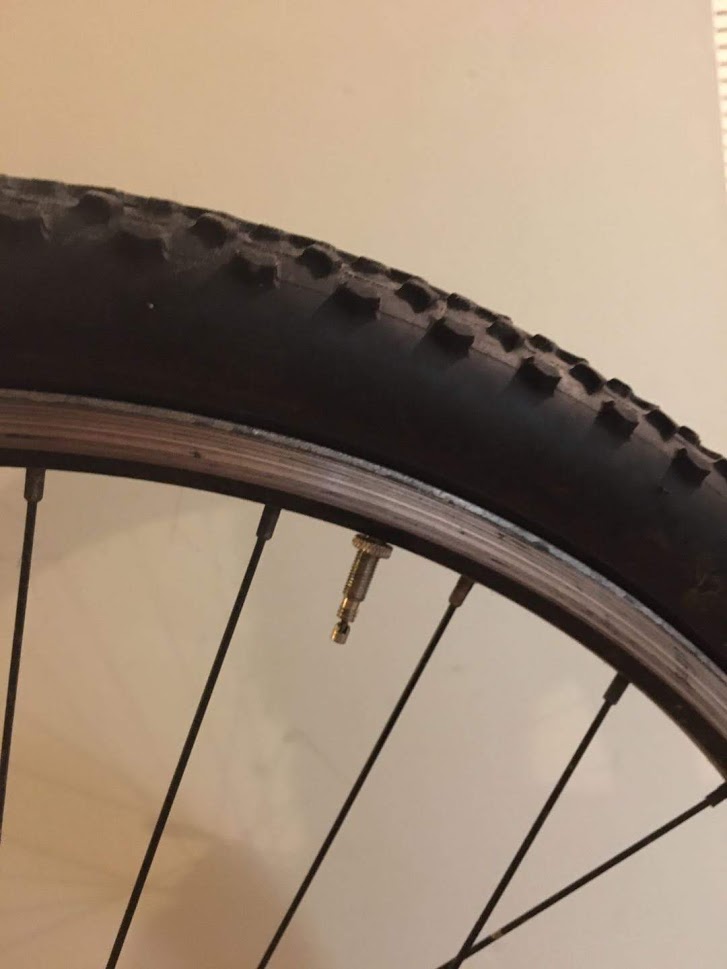 Overinflation has less of an established safety risk, but it still creates negative and costly effects for the tire. Overinflation causes the tires to be tight and more likely to be punctured or cut. You will also be changing your tire’s footprint, which affects its traction. As a result, you will experience irregular tire wear, reducing your tire’s wear life. This can cost between 7% and 15% of the tire life.
Overinflation has less of an established safety risk, but it still creates negative and costly effects for the tire. Overinflation causes the tires to be tight and more likely to be punctured or cut. You will also be changing your tire’s footprint, which affects its traction. As a result, you will experience irregular tire wear, reducing your tire’s wear life. This can cost between 7% and 15% of the tire life.
HOW TO MAINTAIN PROPER INFLATION
According to Fleet Equipment Magazine, tires lose 1-3lbs PSI inflation pressure per month, so it is important to check your tire pressure at frequently. When checking your tire pressure, you want to make sure your truck has been sitting for several hours so that your tires are cold.
During your monthly inspection, it’s not only important to visually look over the tire, but feel for signs of uneven wear. Bob Bortner, our resident expert on alignment, suggests that checking air pressure it is a great time to do a quick check of the tires to look for uneven tire wear.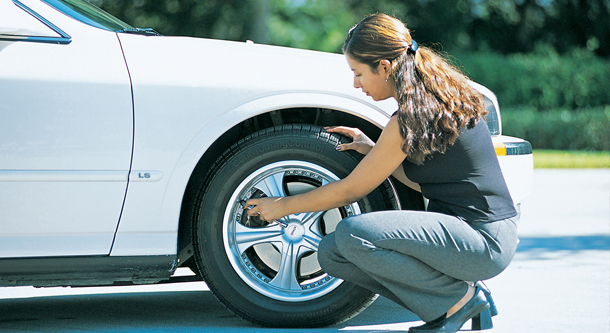 He also says the easiest way to check for tire wear is to run your hands from the outside to the inside of the tire , and then across the tread of the tire. If you feel any sharp edging or feathering across the tire, chances are you have an alignment or component related issue. This quick check can determine if a potential toe issue is present. The toe setting is a direct tire wear angle that can decrease tire mileage considerably when not set properly. The general rule of thumb is if both insides of steer tires are wearing the vehicle is toed out, and if both outsides are wearing, the vehicle is toed in.
He also says the easiest way to check for tire wear is to run your hands from the outside to the inside of the tire , and then across the tread of the tire. If you feel any sharp edging or feathering across the tire, chances are you have an alignment or component related issue. This quick check can determine if a potential toe issue is present. The toe setting is a direct tire wear angle that can decrease tire mileage considerably when not set properly. The general rule of thumb is if both insides of steer tires are wearing the vehicle is toed out, and if both outsides are wearing, the vehicle is toed in.
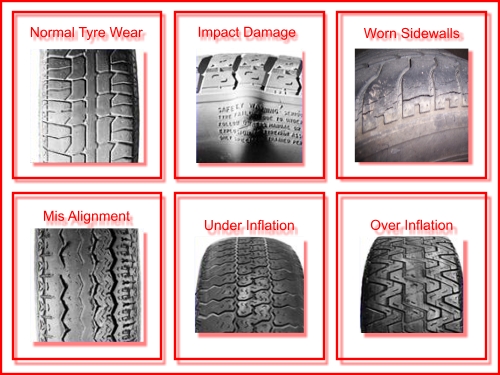 In 2011, tests were conducted to analyze the effectiveness of having TPMS systems in vehicles in order to promote proper tire inflation. This test was done on vehicles ranging from model years of 2004-2011.
In 2011, tests were conducted to analyze the effectiveness of having TPMS systems in vehicles in order to promote proper tire inflation. This test was done on vehicles ranging from model years of 2004-2011. The results found an estimated 71% of all vehicles of model years 2004-2011 have at least one tire that is underinflated by at least 1 PSI, and 12% have at least one severely underinflated tire. Based on the cumulative results of the tests, using a TPMS is estimated to be 55% effective at preventing severe underinflation. The main goal of the TMPS is to reduce underinflation, but the tests also showed improved fuel economy.
 The serious consequences that come with a blowout include potential accidents and harm to your driver as well as other motorists, which is why it is important to protect against punctures by using a tire sealant.
The serious consequences that come with a blowout include potential accidents and harm to your driver as well as other motorists, which is why it is important to protect against punctures by using a tire sealant.Adding sealant is as easy as pouring it into the tires before they are mounted. The natural rotation of the tires on the road will spread the liquid evenly throughout the inside of the tire. The sealant itself is a viscous fluid that incorporates sealing fibers to stop air from escaping in the case of a puncture.
While some sealants can be corrosive to the interior of your wheel, our line of sealants are specially formulated not to become acidic. This means that, unlike some sealants which can only be used as a temporary fix when you repair a punctured tire, our products can be installed when you mount a tire and remain inside the tire during its service life as preventative maintenance.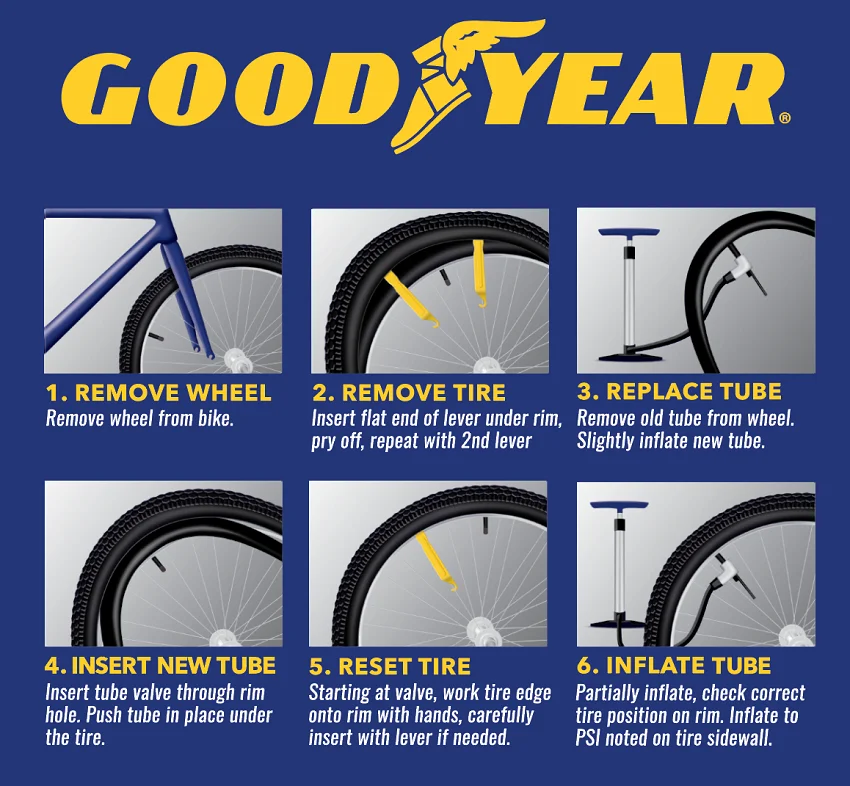
REGULAR TIRE MAINTENANCE IS CRUCIAL
Keeping your tires properly inflated is an extremely important part of your fleet’s regular maintenance regimen. It not only benefits your bottom line, but it keeps your driver and other motorists safe on the roadway. Work with your local tire professional or check your tire manufacturer’s website to get the correct inflation pressure for you. You can learn more about inflation and other maintenance practices by downloading our guide today!
Wednesday, June 16 2021
We all know tires are one of the most invaluable pieces of transportation. Without tires, our vehicles wouldn’t move. And while tires are important, sometimes they pose dangerous situations. Many people are unaware that over- or under-inflated tires create great risk for you and your passengers.
Without tires, our vehicles wouldn’t move. And while tires are important, sometimes they pose dangerous situations. Many people are unaware that over- or under-inflated tires create great risk for you and your passengers.
Did you know any extra PSI can significantly increase your odds of a tire blowout? When you experience a tire blowout, your life and the lives of your passengers are put in harm's way. Since it’s extremely difficult to gain control over your vehicle during a blowout, you’re at the mercy of your tires. Mechanics consider May through October “blowout season.” This is because the increased temperatures paired with poor tire-care and lengthy road trips lead to an increased risk of blowouts.
Damages Your TiresOver-inflated tires don’t just increase the risk of blowouts. Over-inflated tires are also more likely to experience damage from roads. When a tire is properly inflated, the tire can flex and bend around any cracks or divots in the road.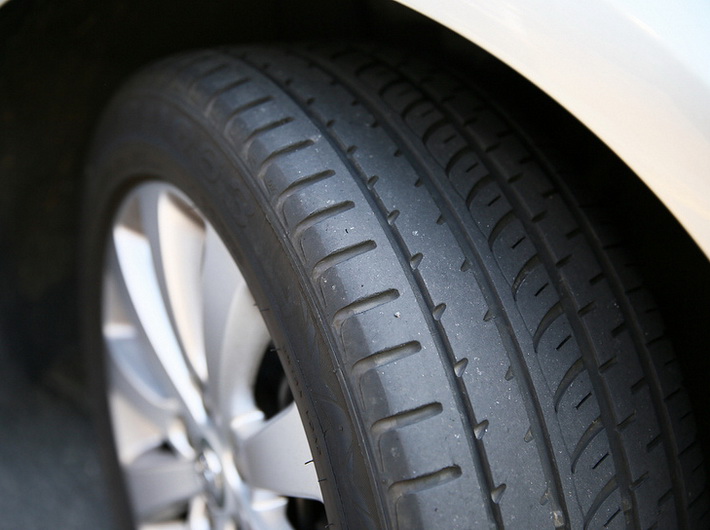 When a tire is over-inflated, it’s more stiff. Simply, it’s unable to bend around these holes, which can ruin your tire. It also makes for an uncomfortable ride!
When a tire is over-inflated, it’s more stiff. Simply, it’s unable to bend around these holes, which can ruin your tire. It also makes for an uncomfortable ride!
Over-inflated tires also cause uneven wear on your tires. This happens because the middle of your tire is extended further than the rest. When this area is overextended, it’s going to experience more wear than the rest of the tread. Uneven wear on your tires means you’ll have to replace them more often. To save yourself the extra money, keep your tires at the recommended PSI.
Signs your tire is over-inflated:
More Friction = More Blowouts
Over-inflated tires aren’t the only worry. Under-inflated tires are just as dangerous and costly. Like over-inflated tires, under-inflated tires also cause blowouts.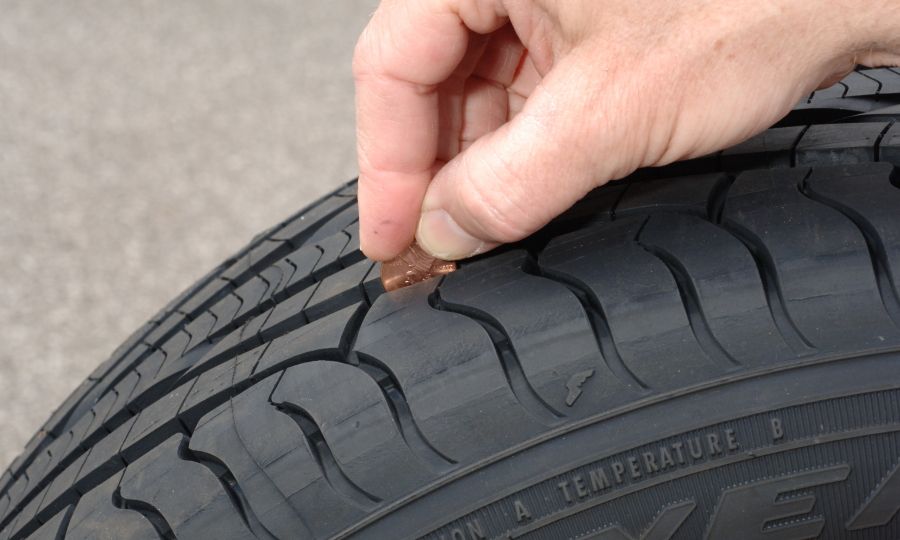 When a tire is under-inflated, more of the tire’s surface area touches the road. This increases friction, which increases heat and leads to advanced wear. It’s the perfect concoction for a blowout.
When a tire is under-inflated, more of the tire’s surface area touches the road. This increases friction, which increases heat and leads to advanced wear. It’s the perfect concoction for a blowout.
Increases Fuel Usage
As with any vehicle, when it’s difficult to move forward, you exhaust more energy. That’s why when your tires are under-inflated, it’s more difficult for the car to push forward. And the more difficult it is to move forward, the more fuel you use. Think about riding a bike with under-inflated tires. I bet you’d pedal with a lot more effort than usual. That effort is considered energy. And the more energy needed, the more fuel usage and cost expand.
Less Vehicle Control
The sidewalls of under-inflated tires contract more than they’re meant to. And more of the tire’s surface touches the ground. Both of these conditions make controlling and maneuvering your vehicle difficult. You’ll notice it’s tough to brake quickly. Because of this, you’re much more likely to be involved in collisions and accidents. Keep yourself and your passengers safe by properly inflating your tires.
Because of this, you’re much more likely to be involved in collisions and accidents. Keep yourself and your passengers safe by properly inflating your tires.
Signs your tire is under-inflated:
Wouldn’t life be wonderful if we could jump into the driver’s seat, not worrying about tire pressure? It would, but unfortunately in this world, it’s considered negligent driving.
The next best thing is a device that keeps your tires at their ideal pressure. With a few clicks of a button, Inflate-R gets your tires to their goldilocks pressure in just a few minutes. Don’t believe me? Check out this video:
Tire pressure can be stressful. It affects your own safety and the safety of those around you. That’s why it’s so important to regularly check your tire pressure.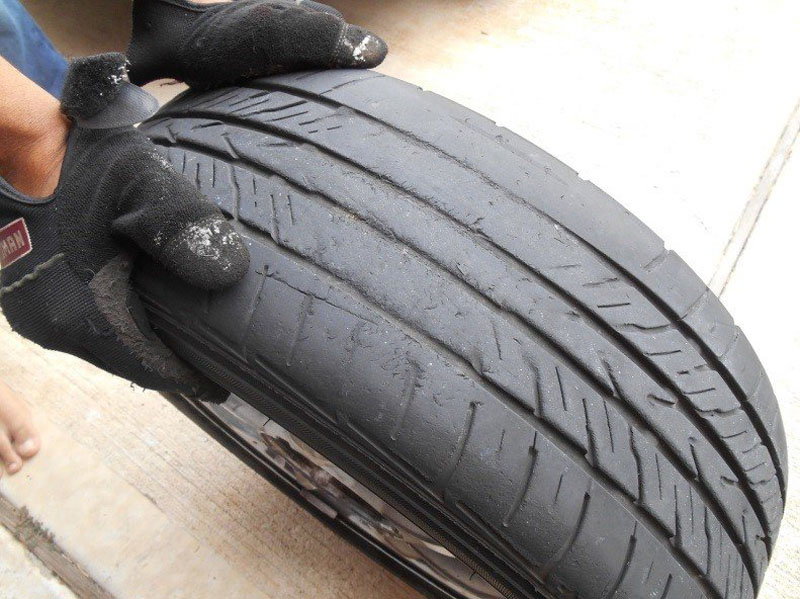 With Inflate-R, you just hook up the device to your tire and immediately your current PSI will appear on the screen. Not the pressure you want? Just adjust the number and click start.
With Inflate-R, you just hook up the device to your tire and immediately your current PSI will appear on the screen. Not the pressure you want? Just adjust the number and click start.
With Inflate-R you can feel confident about your tires.
Claim My Discount
Choose the number of devices you want for you, your family and your loved ones
Inflate-RInflate-R is a portable and lightweight tire pump that conveniently fits in your glovebox or backpack.
Crafted with a safety flashlight, Inflate-R duels as a powerbank. This all-in-one device pumps up to 150 PSI, ensuring you're always prepared and feeling safe.
Claim My Discount
Posted in: air pump, blowout, fuel usage, PSI, road safety, tire, tire damage, tire pressure, vehicle safety
« Back to News
Both truck and passenger tires inevitably wear out during operation, in other words, they wear out.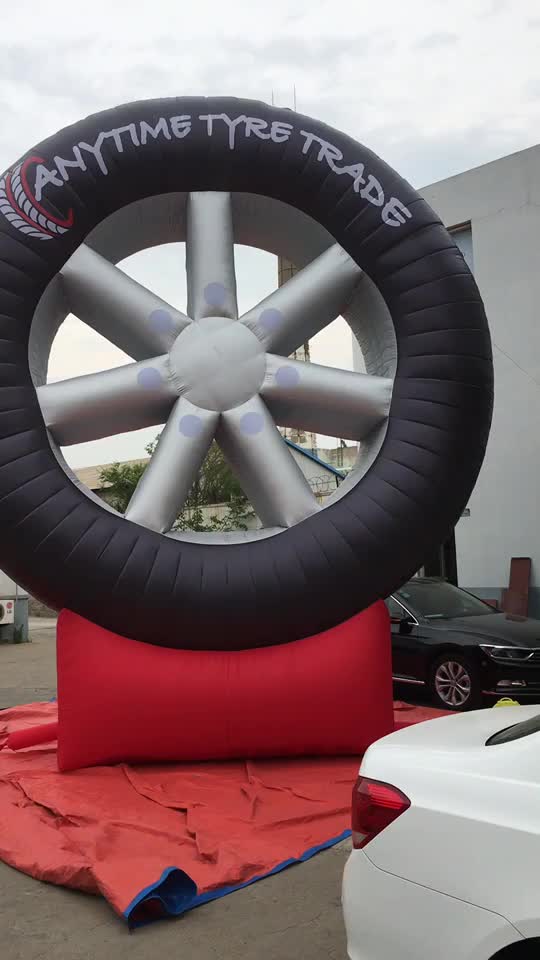 Modern technologies can significantly increase the resource of tires in comparison with previous generations, however, no company has yet invented “eternal” wheels. In addition, we can highlight a list of factors under the influence of which tires wear out many times faster. Taking into account these nuances and their prevention will allow you to enjoy the softness of the movement, the clarity of control and braking for as long as possible without prematurely spending on new tires.
Modern technologies can significantly increase the resource of tires in comparison with previous generations, however, no company has yet invented “eternal” wheels. In addition, we can highlight a list of factors under the influence of which tires wear out many times faster. Taking into account these nuances and their prevention will allow you to enjoy the softness of the movement, the clarity of control and braking for as long as possible without prematurely spending on new tires.
With a lack of air pressure in tires, a whole range of changes is observed, leading to their rapid wear:
 As a result, the wear of the tread shoulder zones is significantly accelerated;
As a result, the wear of the tread shoulder zones is significantly accelerated; At the same time, for an accelerated failure of the rubber, a pressure drop of 0.5 atm is sufficient. On average, this reduces wheel life by 20%.
For tires, not only low, but also high pressure is harmful - when driving on pumped wheels, the rubber will also wear out too quickly. This state of affairs is due to the following points:
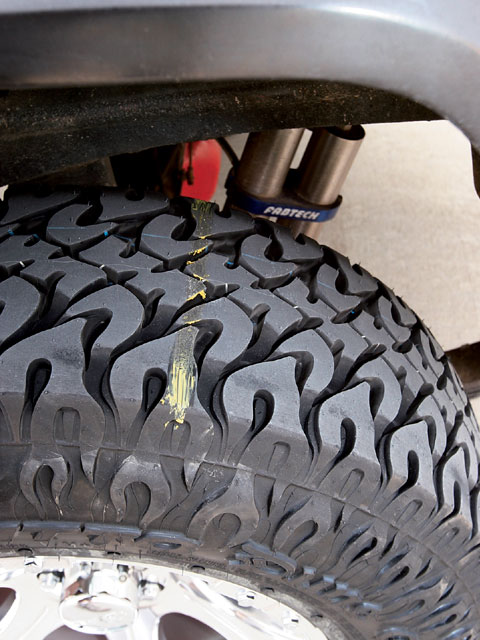 If there is any damage in its structure, then under the influence of heating they can develop into full-fledged hernias and ruptures. In the most severe cases, an overinflated wheel may explode;
If there is any damage in its structure, then under the influence of heating they can develop into full-fledged hernias and ruptures. In the most severe cases, an overinflated wheel may explode; It should be noted that increased tire pressure is less damaging than low pressure.
The wheels of the car are not installed directly perpendicular to the ground, but at a slight angle. This allows you to compensate for the negative impact of longitudinal forces on a rotating wheel and improves vehicle handling. An incorrectly set or misaligned wheel alignment can lead, among other things, to early tire wear. This is due to the following aspects:

As a result, characteristic burrs appear on the tire. Gradually, they increase in size, which indicates irreversible deformations of the wheel structure.
In addition, factors such as:
Our company represents high-quality Goform tires supplied by a certified manufacturer from China. They optimally combine an attractive price that will appeal to any motorist, and high quality, combining the company's own long-term developments and rich world experience in the production of tires.
The high performance rubber compounds used for Goform tires provide them with increased strength and durability. At their affordable price, they are distinguished by outstanding wear resistance and perfectly tolerate driving on far from ideal Russian roads.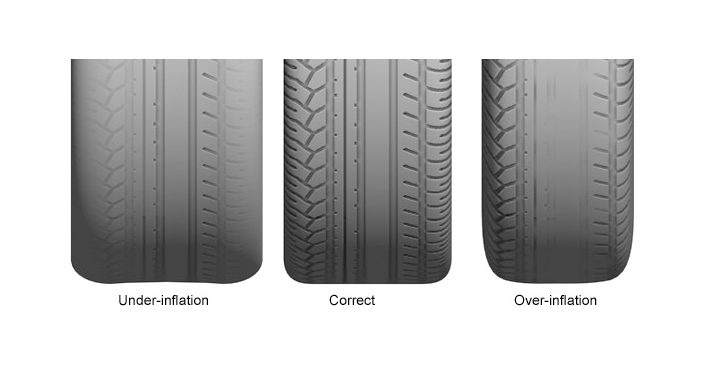 This rubber will serve faithfully for many thousands of kilometers, delighting its owner with slow wear, maintaining the original geometry and strength.
This rubber will serve faithfully for many thousands of kilometers, delighting its owner with slow wear, maintaining the original geometry and strength.
We offer convenient delivery conditions for Goform tires to any region of Russia, a wide range of models and reasonable prices!
With mileage, the technical condition of tires changes, which affects the performance of the car and traffic safety. Therefore, it is important to monitor the uniformity of wear of all tires, and also to prevent the operation of the vehicle, the residual height of the tire tread of which is lower than the minimum allowable. The task of preventing premature wear and destruction of tires is very complex and is associated with the ability to determine their types, accurately identify the cause that caused each specific tire failure. The increased wear of your car tires is influenced by many factors, or, to put it bluntly, violations. The fact is that many car owners do not follow the basic rules for maintaining their own or working car.
The fact is that many car owners do not follow the basic rules for maintaining their own or working car.
This happens either due to ignorance or negligence. Due to the periodic and timely inspection of car tires, you can get complete and necessary information about the condition of the wheels and tires, the degree of wear, identify defects that are dangerous for traffic safety, determine the causes of tire wear and the features of car operation.
In addition to safety, tire condition affects handling, driving dynamics and fuel consumption . The latter is especially important for trucks and car owners with high daily mileage. Some tire manufacturers claim in their flyers that their tires will not only last longer, but will also save fuel. Let's see how tires really affect a car's fuel consumption. In a truck, this is of course more noticeable than in a passenger car, due to the large number of wheels and high loads. The rolling resistance of an entire vehicle consists of a whole list of resistances: air resistance, overcoming inertia forces during acceleration, internal resistance of engine and transmission components, and tire resistance. We will not dwell on all these factors and focus on tires.
We will not dwell on all these factors and focus on tires.
The total rolling resistance of tires is also made up of several components. Contrary to popular belief, tire friction on the road surface of is only 5%. A little more (about 15%) falls on air resistance . The lion's share of the energy expended (about 80%) is spent on tire deformation . If the tire is rolled along the road with no load at all, then before stopping, it will move for a long time. But if the tire is loaded so that its lower part begins to deform (compress), after the initial impulse it will stop very quickly. This clearly demonstrates how much energy is spent on the constant deformation of the tires.
Thus, car owners may want to buy tires that will deform minimally, and therefore create less rolling resistance. Now in the market such an option is quite possible to find. As a rule, these are inexpensive budget-class tires. A stiffer carcass, although it gives some fuel economy, at the same time can present an unpleasant surprise in the form of a tire explosion.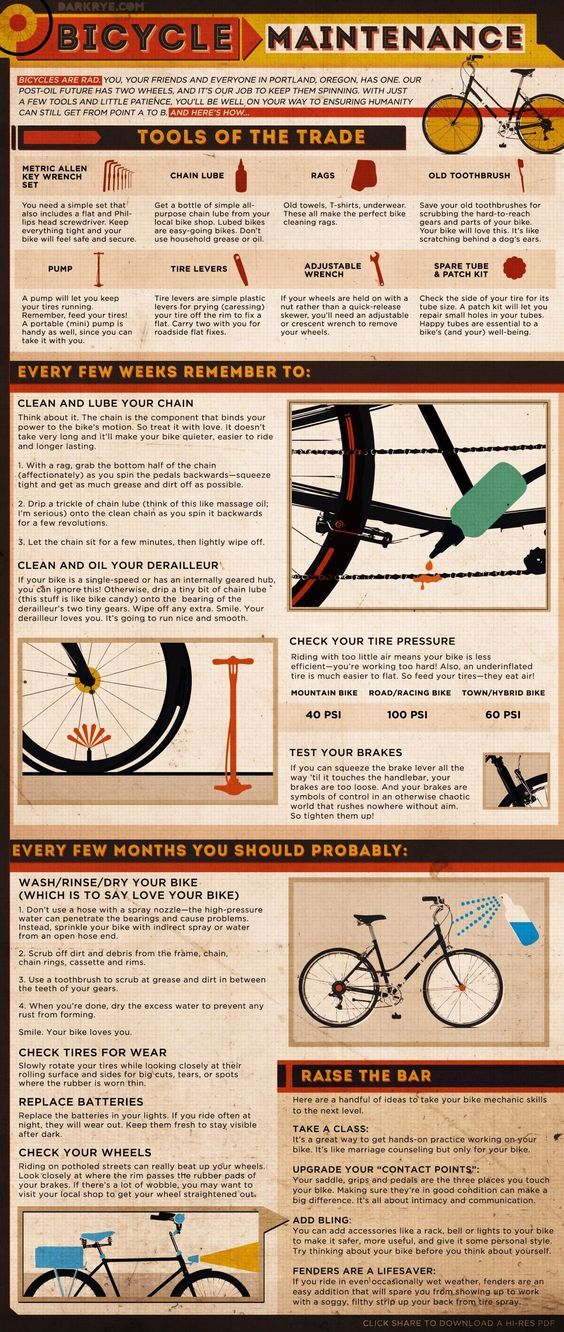 You just need to run into any object with sharp edges (stone, piece of iron, etc.). By the way, a similar situation can happen with premium tires. Some drivers, mostly trucks, inflate their tires on purpose to save fuel, without realizing that uneven wear will appear.
You just need to run into any object with sharp edges (stone, piece of iron, etc.). By the way, a similar situation can happen with premium tires. Some drivers, mostly trucks, inflate their tires on purpose to save fuel, without realizing that uneven wear will appear.
The chassis geometry of the also has a significant impact on fuel consumption. Even minor deviations entail extra costs. Firstly, tires wear out faster, and secondly, fuel burns more. When the wheels, figuratively speaking, go in different directions, additional energy is spent on their "drag". For example, if at one meter the wheel “leaves” only 2.5 mm, then at a kilometer it turns out that the wheel will “drag” to the side by 2.5 m. 2.5 kilometers at full load.
Normal tire wear
Tire inspection provides you with information about the condition of the tires and wheels, how the vehicle is used, possible defects, and driving style. So, for example, a sporty driving style leads to a different tire wear pattern than a relaxed one. For a correct assessment, it is necessary to inspect all the wheels. This is especially evident in the example of a passenger rear-wheel drive car, since the load is distributed differently between the driving and steered wheels in it.
For a correct assessment, it is necessary to inspect all the wheels. This is especially evident in the example of a passenger rear-wheel drive car, since the load is distributed differently between the driving and steered wheels in it.
Tire wear as a function of air temperature
Tire wear as a function of driving speed
While driving, tire wear is determined by measuring the remaining tread height. Tire wear must be uniform over the entire circumference; when the minimum tread height is reached, the tire is considered completely worn out and must be replaced. Tire wear is primarily determined by driving style. Hard acceleration and braking wears out the tire faster than steady motion.
Drive and steer wheels have different wear patterns due to different loads. Steered wheels wear more on the sides, since it is on this part of the tire that the main load in the turn occurs. Tires on drive wheels wear more in the middle , since it is this part of the tire that contacts the asphalt and transmits the rotation of the wheel to the road.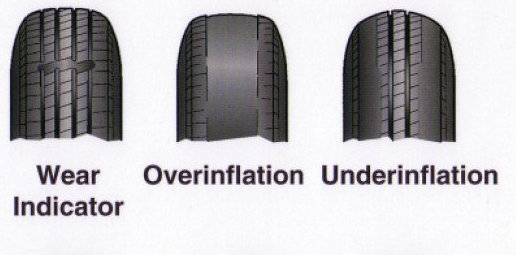 On vehicles with front-wheel drive, the wear is "cumulative" - in this case, the entire tire wears out evenly and its central part and sides.
On vehicles with front-wheel drive, the wear is "cumulative" - in this case, the entire tire wears out evenly and its central part and sides.
One-sided wear (possible reduction in wear from 15% to 30%) - occurs more often than others, since there are several reasons for its occurrence. One-sided tire wear can be caused by an error in suspension geometry. To determine the cause in this case, it is necessary to check the toe-in and camber. Wear on the outer side of the tire can be caused by excessive positive toe or camber . Wear on the inside of the tire, on the other hand, causes excessive negative toe or camber. Driving with zero camber results in even but increased tire wear. In addition, it increases the tire's rolling resistance and increases fuel consumption . In addition to the tires of the steered axle, tires of other axles can also be subject to one-sided wear - again due to problems with the geometry. This is either a lack of alignment, or deformation of the axes themselves.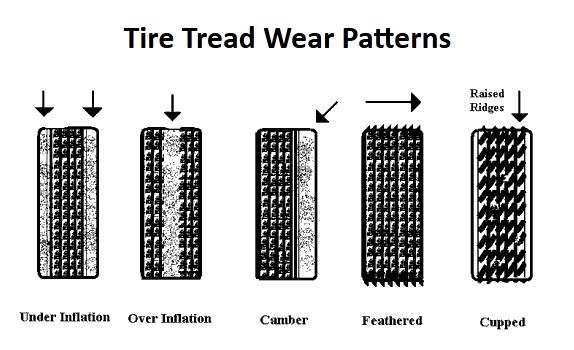 On steering tires for tractors, one-sided wear may appear due to the operating conditions of the vehicle. Another reason is cornering at high speeds. To prevent one-sided wear, you need to monitor the condition of the chassis, periodically check the geometry and abandon the aggressive driving style.
On steering tires for tractors, one-sided wear may appear due to the operating conditions of the vehicle. Another reason is cornering at high speeds. To prevent one-sided wear, you need to monitor the condition of the chassis, periodically check the geometry and abandon the aggressive driving style.
Bilateral and central wear (possible reduction in mileage from 5% to 10%) appear for the same reason - a mismatch in tire pressure. When the pressure is below normal, the tire begins to wear more at the edges, and bilateral wear is obtained. The same thing happens during overload - the tire, even with normal pressure, rides as if it were lowered. Fans of pumping tires get a different result: the load on the contact patch is not distributed evenly, but closer to the center, which means that the tire wears out faster in the central part of the tread. Anyone who monitors tire pressure and does not overload the car does not encounter such problems.
Multiple wear around the circumference
Patchy wear (possible 10% to 20% reduction in mileage) is a direct result of imbalance. It is especially characteristic of steering axle tires, but can appear on all axles. If such wear has become visible to the naked eye, the problem is obvious. Balancing will correct the situation, but only partially: a wheel that has lost its roundness will wear out more intensively. Therefore, it is more expensive to ignore balancing when buying and installing new tires. Repeated wear spots around the circumference of the tires can cause suspension failure (arms, dampers, springs). After diagnosing and repairing the suspension, the tire must be replaced, since this wear pattern no longer ensures its uniform rotation, and the wheel will “beat”.
Spot wear
Spot wear in one spot is the result of emergency braking with a locked wheel. The uniformity of rotation of the wheel in this case is also broken and the tire will have to be replaced.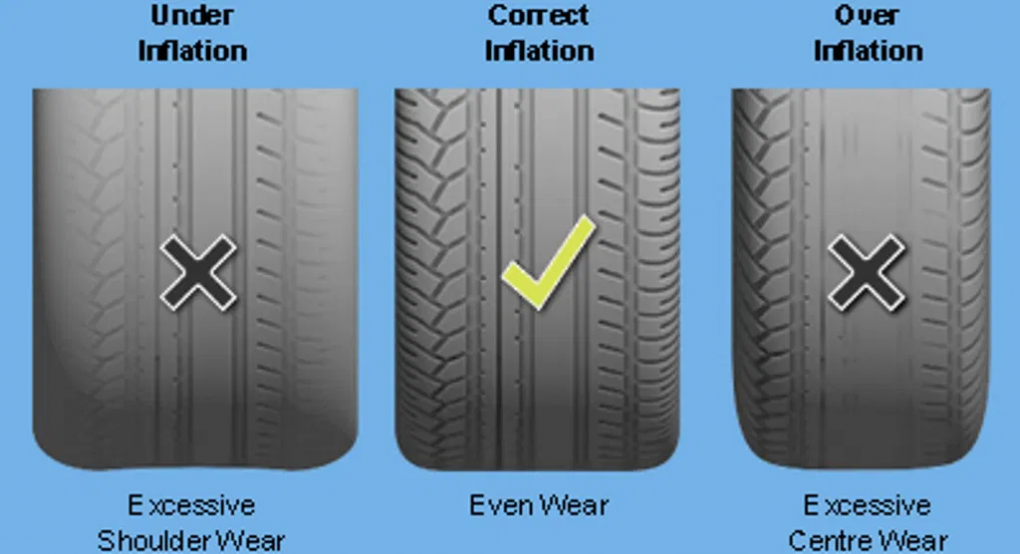 If you leave the car for a long time in the parking lot, then there is a risk of flat areas on the tires, which then during the movement will cause the wheels to vibrate. It is recommended to increase the pressure in the tires if you leave the car for a long time. A similar effect can also be caused by stopping the car after intense sports driving - heated tires are easily deformed at the points of contact with the road surface and practically “freeze” in this state. This defect is easy to fix - after warming up the tires, they will again acquire a round shape.
If you leave the car for a long time in the parking lot, then there is a risk of flat areas on the tires, which then during the movement will cause the wheels to vibrate. It is recommended to increase the pressure in the tires if you leave the car for a long time. A similar effect can also be caused by stopping the car after intense sports driving - heated tires are easily deformed at the points of contact with the road surface and practically “freeze” in this state. This defect is easy to fix - after warming up the tires, they will again acquire a round shape.
Comb (sawtooth) wear (possible reduction in mileage from 10% to 20%) is a form of uneven wear. It can often be seen on drive axle tires with a block tread pattern. It is caused by the fact that during the movement the tire is deformed - at the point of contact with the road, the tread is pressed inward (the blocks are crushed and dragged along the road surface), and as the wheel rotates, it straightens again. This leads to the fact that the tread wears more on the front edge than on the back. The result of this wear is an increase in tire rolling noise. It is impossible to avoid the appearance of comb wear, but with the help of permutations, its negative effect on tire mileage can be leveled. Drivers can also influence the situation: if you step on the gas pedal as smoothly as possible, comb wear will be minimal. To even out this wear, tires are usually swapped, as tires on a non-drive axle are more susceptible to this wear. Low tire pressure also increases sawtooth wear.
This leads to the fact that the tread wears more on the front edge than on the back. The result of this wear is an increase in tire rolling noise. It is impossible to avoid the appearance of comb wear, but with the help of permutations, its negative effect on tire mileage can be leveled. Drivers can also influence the situation: if you step on the gas pedal as smoothly as possible, comb wear will be minimal. To even out this wear, tires are usually swapped, as tires on a non-drive axle are more susceptible to this wear. Low tire pressure also increases sawtooth wear.
Driving with the wrong tire pressure
Insufficient tire pressure causes the tire to flex in the middle and wear out at the edges as a result. Excessive pressure in the tire leads to the opposite effect - its middle part wears out. It is authentically known that it is impossible to create an ideal tire. If you make it economical, it will be too rigid and unsafe. Conversely, a soft, durable tire with good grip will inevitably have increased rolling resistance.